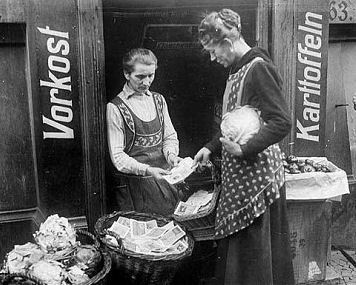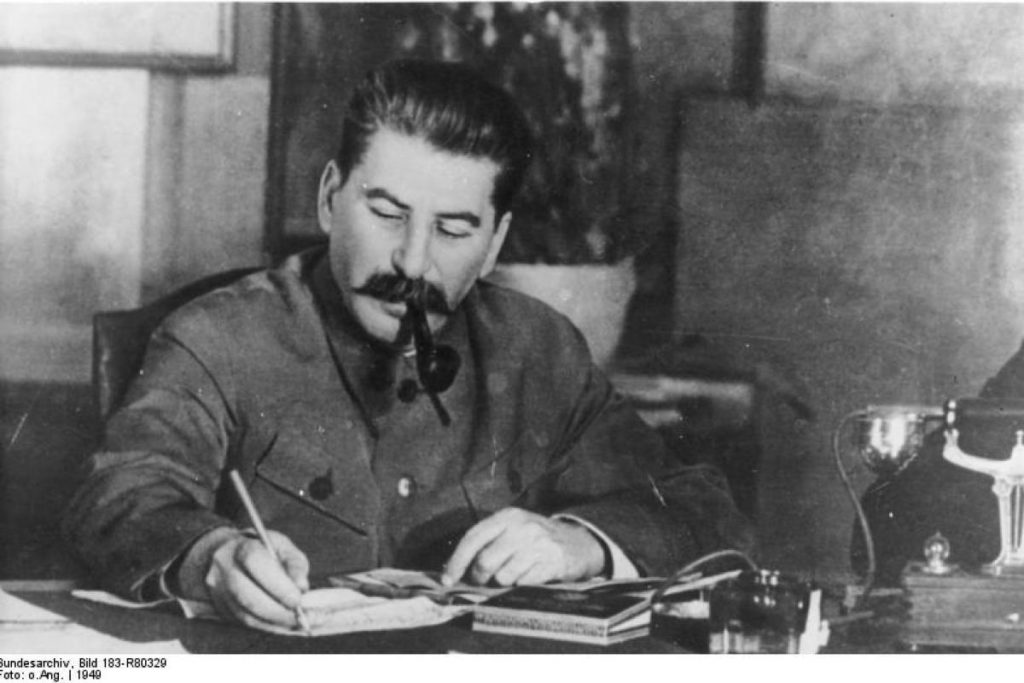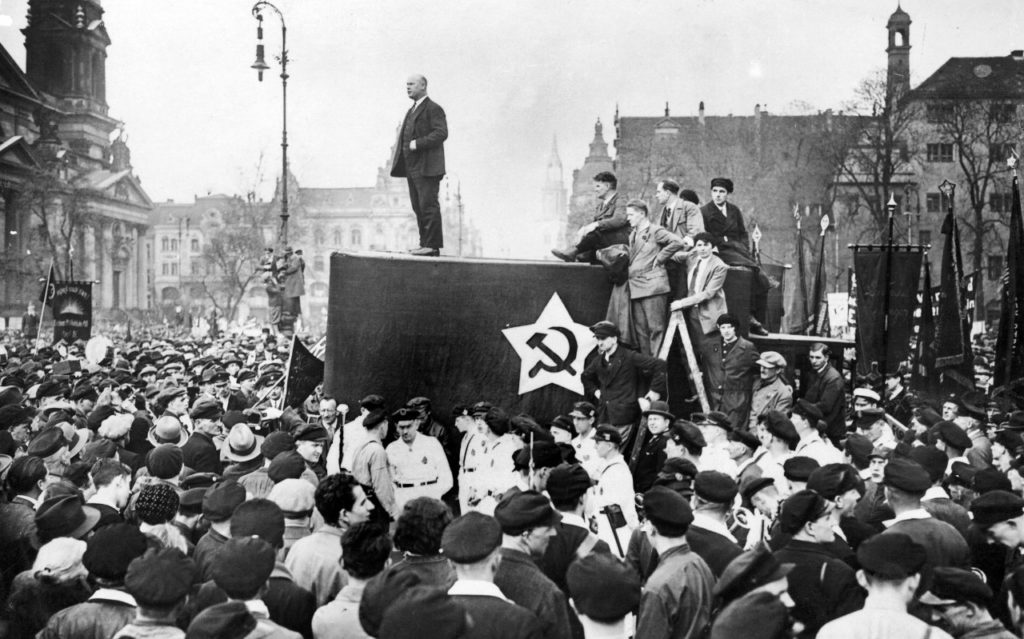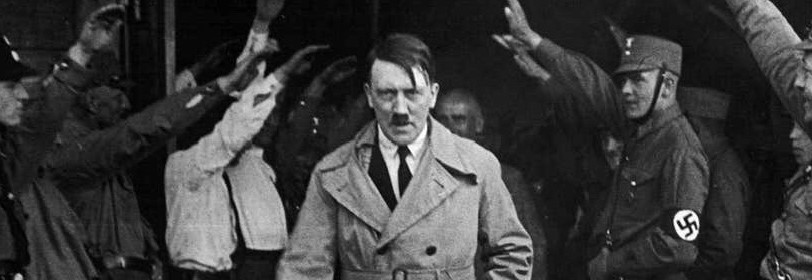By Cain O’Mahony
The events of 6 January in Washington, when neo-Nazis and other assorted weirdos stormed Capitol Hill, was a reminder of the latent threat of reaction that lies beneath the smooth veneer of mainstream capitalism. It is therefore timely to remind ourselves of the rise of Hitler.
One hundred years ago in a meeting hall in Munich, a small, insignificant fascist party elected a new leader – Adolf Hitler. There were just over 500 delegates present, representing its 2-3,000 members, miniscule compared to the mass movements that were raging across the newly formed Weimar Republic. Taking over the National Socialist Germany Workers Party (NSDAP – the Nazis), Hitler’s first act in 1921 was to dissolve all party structures leaving him, and him alone, as the party’s leader – or Fuhrer – and form a paramilitary wing called the Sturmabteilung, the SA or ‘Brownshirts’.
So how did this miniscule group rise to engulf two decades of the 20th century in flames, mass death and destruction?
The root of the cause was the defeat of German Imperialism in World War I. While the Kaiser and his military junta did have absolutist rule, with the parliament allowed to vote on legislative matters only, that house was dominated by the Social Democratic Party (SDP) which had mass support throughout the country. Fearing mass taxation to pay for the war would cause revolt, Germany had foolishly attempted to fund its war effort through borrowing money, rather than imposing taxes on the populace. This left Germany in 1918 with massive debts, and only defeat to show for it.
On top of this, in a short-sighted act of revenge, the Allied Imperial powers demanded swingeing reparations that carved up the country, which could only stoke the fire of revolutionary change.
Revolutionary uprisings
The end of the war had led to revolutionary uprisings, propelling the SDP into power with the formation of the Weimar Republic. Its leadership was of the reformist kind, eager to demonstrate its credentials in efficient management of capitalism, with perhaps a few reforms on the way. In the Spartakus League uprising in Berlin in 1919 – a premature, ultra-left act which saw the murder of the two giants of German Marxism, Rosa Luxemburg and Karl Leibkneckt – the SDP government had no qualms in ordering the right wing, nationalist Freikorps, made up of disgruntled demobilised soldiers, to brutally suppress these forerunners of the German Communist Party (KPD).
Yet their attempts to manage capitalism were made impossible by the Allies. A further reparation was the ‘London Ultimatum’ of 1921 that demanded Germany pay the Allies two billion gold marks every year, as well as 26 per cent of the value of annual exports. Already being off the Gold Standard, the Republic printed money to buy foreign currency to meet the imposed debts. Over the next three years hyperinflation wracked the Republic, destroying small businesses and leading to mass unemployment.
In this hellish existence, the Nazis began to grow. In the revolutionary upheavals of 1923, a small growth in Nazi-party membership convinced Hitler that he could emulate Mussolini’s successful ‘March on Rome’, which had put the National Fascist Party in power in Italy. The ‘Beer Hall Putsch’ was a disaster, and Hitler was briefly imprisoned. He abandoned the putschist method that had worked for Mussolini, and instead saw the route to power by climbing on the back of conservative German nationalism and – as its support withered away – replace it.
Middle classes ruined
Their targets were the middle classes being ruined by hyperinflation and then recession, and the backward layers of the working class, demoralised at the SDP’s and KPD’s failure to see through socialist revolution in the ‘March Events’ of 1921 and the ‘Lost Revolution’ of 1923 (see Germany 1921: the lessons of the ‘March days’ – Left-Horizons (left-horizons.com). With it came the tool of all reactionaries, the fear of the ‘other’. In Germany, the traditional target was the Jewish community. Hitler took this anti-semitism to its extreme, curdling it into a nonsensical conspiracy theory that Jewish Bolshevik leaders were in alliance with Jewish bankers and capitalists to destroy Germany.

The Nazi’s apparent ‘socialism’ extended only to the ‘Herrenvolk’ of course. Leon Trotsky, in his analysis of the Nazis wrote:
“Not every exasperated petit-bourgeois could have become Hitler, but a particle of Hitler is lodged in every exasperated petit-bourgeois… Decorated with medals for distinguished service, commissioned and non-commissioned officers could not believe that their heroism and sufferings for the Fatherland had not only come to nought, but also gave them no special claims to gratitude. Hence, their hatred of the revolution and the proletariat. At the same time, they did not want to reconcile themselves to being sent back by the bankers, industrialists and ministers to the modest posts of book-keepers, engineers, postal clerks and school teachers. Hence their ‘socialism’. “ (What is National Socialism? 1933).
The disorientation of the KPD
At this early stage of Nazism, the mass socialist forces should have recognised the growing threat and crushed it. Instead, the KPD pandered to them, and even gave their ‘socialism’ credence.
During World War I, after the SDP leadership had backed the war ‘in defence of Germany’, there was a massive split-off by the left in 1917, which formed the Independent Social Democratic Party (USPD). It was in the main a centrist party, which vacillated between revolution and reformism. In 1920, the left of the USPD voted to affiliate to the new ‘Communist International’ (the Comintern) led by Bolshevik Russia, and left the USPD and joined the KPD en-masse – the KPD had 78,000 members but were joined by 300,000 former USPD members, making it a mass party overnight.
While this was a massive victory, this sudden mass influx educated in the ‘centrist’ tradition, disorientated the KPD, and they became more reliant on the ‘party line’ from Moscow on tactics. But the ‘Mother of the Revolution’ was in turmoil too. Lenin had been struck down by a stroke in 1922, and his health deteriorated the following year. During 1922-23, a power struggle was developing within the Bolshevik leadership as bureaucratic tendencies came to the surface – Stalin formed an alliance with Zinoviev and Kamenev against Trotsky, as Lenin lay ill. The death of Lenin and the triumph of the bureaucratic faction, and its subsequent control of the Comintern, spelt disaster not just for Germany but for revolutionary movements across the world.
In this situation, the role of the Comintern was of inestimable importance: where the leadership of the working classes and Communist Parties abroad were unsure of itself or made mistakes, the vast experience acquired by the Bolsheviks in their successful revolution was needed to correct these mistakes and guide the fledgling Communist movements abroad to a correct understanding of the tasks that faced them.
But by 1923 with Zinoviev at the head of the Comintern and Stalin General Secretary of the Russian party, all the preparatory work of Lenin, Trotsky and the ‘Old Bolsheviks’ began to be unravelled by the bureaucratic clique, more interested in manoeuvring to retain power than developing a far-sighted perspective, or – heaven forbid – admitting and correcting mistakes when they made them.
Ideas of Lenin distorted
The original ideas outlined by Lenin now became distorted. In 1921, Lenin and Trotsky had formulated the ‘United Front’ policy where the task of Communists, by working alongside the masses, was to show how the reforms promised by the SDP could only be given any real meaning by overthrowing capitalism itself, whilst placing demands on the Social Democrats and exposing them in the eyes of the masses when the SDP did not – or could not – deliver, because of the confines of the capitalist system they had imprisoned themselves in. In this way, the KPD would break the reformist hold of the SDP over the working class, and bring the masses behind the KPD.
Yet now, in June 1923, Radek – the Comintern’s representative for Germany – told the Executive Committee of the Comintern that the KPD should form a United Front with the far right against the SDP who, he said, were the main barrier to revolution. This was no off-the-cuff remark: the speech had been prepared by the Politburo of the Russian Communist Party and backed by Zinoviev.
The KPD swallowed the Comintern’s line, and its paper, Die Rote Fahne, opened its columns to Nationalists; Nazis spoke at KPD meetings, and vice versa. Joint rent strikes were held where the hammer and sickle flag flew alongside the Swastika.
This mad tactic only ended when the Nazis ordered no more joint work – but the damage had been done, with the more backward workers thinking that if the representatives of October 1917 could give their approval to the Nazis, the Nazis could not be as much of a threat as feared.
‘Third Periodism’ – facing the wrong enemy
Such tactics were a precursor for the fatal consequences of the ultra-left ‘Third Periodism’ of Stalin, who by 1928 had consolidated full control of the Comintern.

The ‘Third Period’ perspective was declared to be a period of the immediate collapse of capitalism, which would automatically drive the masses into the arms of the KPD. All those parties which did not agree with the KPD were labelled as counter-revolutionary and lumped together in the camp of fascism. The SPD, whose leadership was seen as the agency of capitalism, was dismissed as ‘social-fascist’ and the ‘left wing of fascism’, which meant it was out of the question to form any kind of United Front with it. In fact, the Social Democracy was deemed to be more dangerous than fascism itself, so that the KPD adopted the policy of first defeating the SDP and then dealing with fascism.
This dangerous position extended down to rank-and-file level, with the KPD forming its own trade union – the RGO, the Revolutionary Trade Union Opposition. Under the slogan of ‘All out of the organisation of social-fascist traitors’, they emptied their members out of the mass trade unions at shop floor level, cutting themselves off from the mass of the labour movement.
This perspective of ‘dealing with the Nazis later’ seemed confirmed in the Reichstag elections of May 1928. With unemployment falling to 650,000 and wages increasing by an average of 10 per cent, there was a sense of recovery amongst the people, which was reflected in the election results:
- SDP – 9.15 million votes
- German Nationalist Party – 4.3 million votes
- KPD – 3.2 million votes.
The Nazis only managed to secure a paltry 810,000 votes.
Hitler however, was not being idle. While he looked to the middle class for membership and votes, he turned to big business for finance.
Useful weapon
German big business, having escaped with its life in the failed revolution of 1923, was looking for an effective means of protecting its interests in the future. Even at that time the politically advanced section of the bourgeoisie recognised in Hitler a useful weapon against the threat of revolution, to be kept in reserve.
Equally, they supported Hitler’s promise of German expansionism. The power house of German industry – in particular, coal, iron and steel – had always been encircled and constrained by French, British and Russian imperialism, which had been the main cause of World War I in the first place. Now this was even more the case, not only by the new Soviet Union in the east, but the stranglehold of reparations with the ever-present threat by the Allies to re-occupy the Ruhr if reparation payments were not met. As Trotsky put it, German big business was like the animals “… in a series of cages in a Provincial Zoo”, never able to break out and exploit European markets. Hitler was the only advocate of German expansionism, by military force if necessary.
The key conduit between big business and the Nazis was the wealthy industrialist Emil Kirdorf, chief shareholder of the Gelsenkirchen Mine Co., founder of the Ruhr Coal Syndicate, and who controlled the political funds of the North West Iron Association. Money began to flow into the Nazi’s coffers, including from the likes of steel and mining magnates Hugo Stinnes, Fritz Thyssen and Albert Voegler.
In 1927, the ‘Circle of Friends of the Economy’, a pro-Hitler lobbying group, was established in order to strengthen ties between prominent industrialists and members of Hitler’s inner circle. In 1929, Hitler scored an important coup in a plebiscite on a new agreement proposed by the Allies on reparations. It was a better deal but the right wing of the mainstream German National Party – and of course the Nazis – were against any reparations. The leader of the GNP, Hugenberg, said he would campaign against it: Hitler offered to give his support, and as Hugenberg owned a large slice of the German media, it gave Hitler a huge profile.
The campaign also gave the Nazis inroads into the huge mass of small farmers and peasants who usually backed the GNP, but whose loans and mortgages were now a crippling burden. Hitler promised an agricultural programme of state credits, remission of taxes, cheaper manure, cheaper electricity and revision of inheritance laws.
The ‘ideological demarcation’ lines blurred
Then came the Wall Street crash. Again, it appeared to the KPD that the ‘Third Period’ perspective of the collapse of capitalism was being borne out.
The government, a coalition of the SDP and the liberal German People’s Party, had already been a luke warm ‘chalk and cheese’ alliance, and soon shattered as unemployment rocketed to three million in 1930. The subsequent election in September was a political earthquake – the Nazis, ridiculed in 1928, saw their vote increase by 800 per cent, with 6.4 million votes giving them 107 seats in the Reichstag, making them the second largest party after the SDP.
The KPD made gains too, achieving 4.6 million votes. But this only disorientated the KPD further, reinforcing its ‘Third Period’ perspective, despite the reality staring them in the face. The KPD leader, Ernst Thalmann, soothed: “14th September was the high point of the National Socialist movement in Germany. From now on it can only decline and fall” (Rote Fahne, 16 September 1930).
Now, under pressure from the growth of the Nazis, yet still locked into Third Periodism, the KPD began opportunistically to emulate the Nazis, using their emotive nationalist language, hoping to win over their supporters. In particular, they parroted the Nazi slogan of a ‘People’s Revolution’. It only reinforced Nazi support. Trotsky complained that “the KPD’s opportunist policy of clothing itself in the apparel of the enemy… only served to strengthen it” and that adopting the slogan of the ‘People’s Revolution’, as opposed to the proletarian revolution had: “…merely helped to erase the ideological demarcation between Marxism and fascism, and reconcile part of the workers and the petit-bourgeoisie to the ideology of fascism, allowing them to think that they are not compelled to make a choice, because in both camps it is all a matter of a ‘people’s revolution’” (Thalmann and the ‘People’s Revolution’).
Yet Thalmann would not deviate from the Moscow line, as late as 1931 still ruling out a united front with the SDP to stop Hitler: “The social-fascists know that there is no possibility of mutual co-operation between us and them. With the battleship party, with the police-socialists, with the forerunners of fascism, there can only be a fight to the death, as far as we are concerned… There is not a single person in the Communist Party who thinks that fascism can be defeated with the help of social-fascism” (Rote Fahne, March 1931).

This caused huge splits in the KPD. In 1931, Hitler again joined forces with Hugenberg’s nationalists to demand a plebiscite, this time calling for the dissolution of the SDP-led coalition controlling the Prussian Landtag (regional government). Prussia was the largest state, covering two thirds of the country, and whoever controlled it effectively controlled Germany.
‘Red referendum’
This was a clear assault on the forces of the left by the forces of the far right, and, correctly, in April the KPD declared its opposition to the plebiscite. But, on the instructions of Stalin, Thalmann overturned the decision, to maintain the party line of the United Front with the Nazis. Worse still, the KPD leadership dressed up the reactionary plebiscite as the ‘Red Referendum’.
It only strengthened the Nazis further – it had been the last chance for the KPD leadership to correct its suicidal path and unite with the SDP to stop Hitler. Much of the KPD rank and file, along with millions of their supporters, expressed their anger at the leadership by refusing to vote in this so-called ‘Red Referendum’.
As late as 1932, the position was not hopeless. Many workers were still prepared to fight, as clearly demonstrated by the bloody battle of Altona, near ‘Red Hamburg’, on 17 July 1932. The Nazis with a heavy police escort, attempted to march through the working-class district of the town; the workers fought back, with the bitter fighting leaving 19 dead and 285 wounded – so much for the myth of Hitler obtaining power ‘without a shot being fired’.
‘United Front’ offered – too late
In a panic, the realisation of a desperate need for a United Front with the SDP suddenly dawned on the KPD. On 22 June 1932 they offered to form a United Front with the SDP against a possible Nazi takeover of the Prussian Landtag, following the plebiscite (which they had backed!). Then, on 30 July, they made a joint call for a General Strike. But it was too late – the call was not heeded because it was not accompanied by the abandonment of the ‘social-fascism’ policy and an honest reappraisal of the incorrect path they had previously chosen. SDP workers, understandably after the past four years, did not trust the KPD, while the KPD rank and file were thrown into confusion by this sudden, unexpected policy zig-zag, which was clearly inconsistent with the ‘theory of social-fascism’.
And Hitler drove right through the middle. With the labour movement still irreconcilably split in two, the Nazis gained 13 million votes in the July 1932 elections, making it the largest party in the Reichstag.
The German ruling class still felt they could keep control, keeping the Nazis as an auxiliary ‘second eleven’. They still feared that unleashing the Nazis could provoke a civil war with all its possible revolutionary consequences – combined, the SDP and KDP vote was still also 13 million, so the country was evenly split down the middle.
The horse-trading between Hitler and various bourgeois representatives dragged on, achieving little, and all the time it was sensed that Hitler was beginning to lose support, being seen as ‘just another talking shop’ politician. The German ruling class feared time had run out, so it was Hitler or nothing. In November, on behalf of the ruling class, the Cologne banking magnate Kurt von Schroder sent a letter, signed by many bankers and industrialists, to the President, Hindenberg, demanding he appoint Hitler to form a government, which, eventually, on 23 January 1933, he conceded.
Hitler’s actions were swift. He passed an Enabling Act suspending the German constitution. The Civil Service was purged and replaced by Nazis. An auxiliary police force was formed, made up of 40,000 SA and SS troops. These, in turn, were unleashed when Hitler called for elections to ensure him the two thirds majority he needed in the Reichstag. Opposition meetings were broken up, opposition candidates arrested and over 50 leading SDP and KPD activists murdered. On 27 February the Reichstag fire was staged and blamed on the KPD. All the leading members were arrested, and then the party made illegal. In March and April, local trade union offices were ransacked, and on 2 May the trade unions were forcibly dissolved. In the same month, the SDP suffered the same fate. The concentration camps were open for business.
The rise of Hitler demonstrated that the capitalist economic model knows no bounds in its pursuit to defend its profits. And it is a warning from history for us all that a false perspective of underestimating a threat – and then refusing to correct it when reality is staring you in the face – can have deadly consequences, not just for the left but society as a whole.



